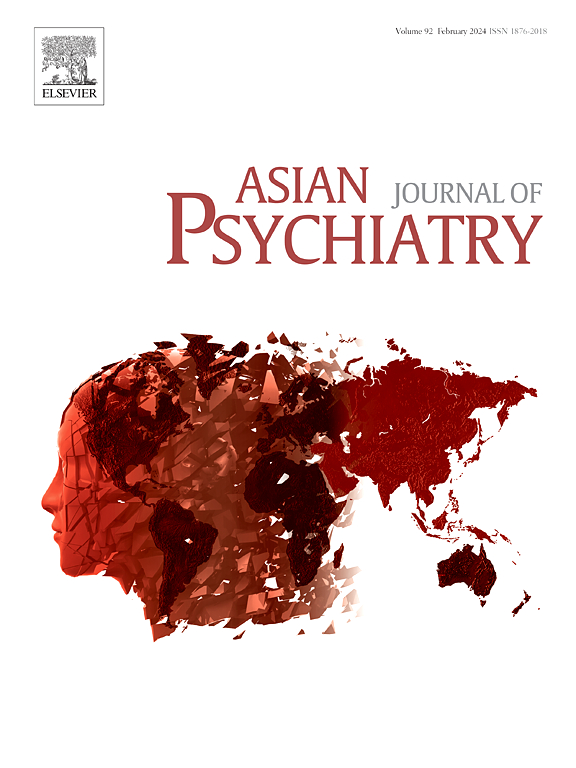The effectiveness of repetitive transcranial magnetic stimulation (rTMS) in patients with catatonia associated with another mental disorder: A systematic review
IF 3.8
4区 医学
Q1 PSYCHIATRY
引用次数: 0
Abstract
Background
Catatonia is a rare but life-threatening condition characterized by a constellation of psychomotor disturbances. The most widely used treatments of catatonia include benzodiazepines and electroconvulsive therapy. Despite the widespread use of benzodiazepines and the high response rate of catatonia to ECT, there are instances where catatonia does not respond to first-line treatments. This study aimed to evaluate the efficacy of repetitive transcranial magnetic stimulation (rTMS) in managing catatonia.
Methods
A systematic literature search was conducted on the following databases: Medline, PubMed, Cochrane Library, Embase, PsycINFO and ClinicalTrials.gov for registered but not yet published studies.
Results
Out of 244 initially identified articles, there remained eight case reports and 1 case series eligible after screening. Of the twelve total cases, nine showed clinical improvement. However, there was significant heterogeneity in the complexity of the clinical situation, the severity of clinical features of catatonia, underlying causes, and rTMS treatment protocols between studies.
Conclusion
The results of this study are inconclusive. However, rTMS might be trialed for the management of catatonia when first-line treatment options fail, are unavailable, or need to be used with caution. Our review incorporating the most up to date evidence highlights the need for more extensive, standardized, randomized clinical trials to investigate the efficacy of rTMS for treating catatonia.
重复经颅磁刺激(rTMS)对伴有其他精神障碍的紧张症患者的疗效:系统综述。
背景:紧张症是一种罕见但危及生命的疾病,其特征是一系列精神运动障碍。紧张症最广泛使用的治疗方法包括苯二氮卓类药物和电休克疗法。尽管苯二氮卓类药物被广泛使用,而且紧张性精神障碍对电休克疗法的反应率很高,但有时紧张性精神障碍对一线治疗无效。本研究旨在评估重复经颅磁刺激(rTMS)治疗紧张症的疗效:在以下数据库中进行了系统的文献检索:方法:在以下数据库中进行了系统的文献检索:Medline、PubMed、Cochrane Library、Embase、PsycINFO 和 ClinicalTrials.gov,检索已注册但尚未发表的研究:在 244 篇初步确定的文章中,经过筛选,仍有 8 篇病例报告和 1 篇系列病例符合条件。在总共 12 个病例中,9 个病例的临床症状有所改善。然而,不同研究在临床情况的复杂程度、紧张症临床特征的严重程度、潜在病因和经颅磁刺激治疗方案等方面存在明显的异质性:结论:这项研究的结果尚无定论。然而,当一线治疗方案失败、无法使用或需要慎重使用时,经颅磁刺激疗法可试用于紧张症的治疗。我们结合最新证据进行的综述强调,有必要进行更广泛、标准化、随机化的临床试验,以研究经颅磁刺激治疗紧张症的疗效。
本文章由计算机程序翻译,如有差异,请以英文原文为准。
求助全文
约1分钟内获得全文
求助全文
来源期刊

Asian journal of psychiatry
Medicine-Psychiatry and Mental Health
CiteScore
12.70
自引率
5.30%
发文量
297
审稿时长
35 days
期刊介绍:
The Asian Journal of Psychiatry serves as a comprehensive resource for psychiatrists, mental health clinicians, neurologists, physicians, mental health students, and policymakers. Its goal is to facilitate the exchange of research findings and clinical practices between Asia and the global community. The journal focuses on psychiatric research relevant to Asia, covering preclinical, clinical, service system, and policy development topics. It also highlights the socio-cultural diversity of the region in relation to mental health.
 求助内容:
求助内容: 应助结果提醒方式:
应助结果提醒方式:


